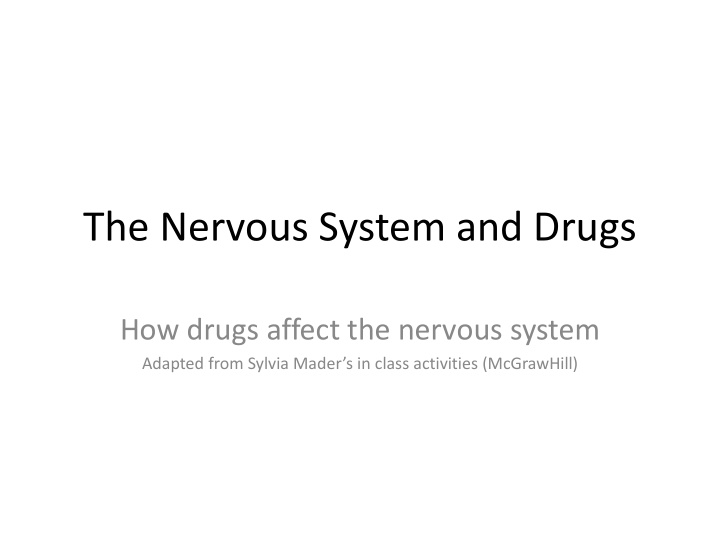



The Nervous System and Drugs How drugs affect the nervous system Adapted from Sylvia Mader’s in class activities (McGrawHill)
Objectives During this activity the students will: • Explain the basic modes of action of several drugs and chemicals that affect the central nervous system (interpretation, communication). • Draw a graph that demonstrates the effect of organophosphates and carbamates on acetylcholine esterase activity (calculation, interpretation and representation, application/analysis, assumptions). • Demonstrate understanding of the action of benzodiazepines by explaining how those could be used in a sinister/illegal fashion as a “date rape” drug (interpretation, communication, analysis).
The Nervous System and Drugs • Students will work in groups of four • Students will assume the role of a student in the process of finishing a pharmacy technician program • Reinforce and understand the modes of action of certain drugs and chemicals in the CNS using examples that may be familiar to the students • Students will be called on to present their group’s answers to class.
Activity • How do Selective serotonin reuptake inhibitors (SSRIs) work? • Graph of AChE activity vs. OP or carbamate concentrations. • Rationale for using Carbamates as Alzheimer’s treatment.
How do Selective serotonin reuptake inhibitors (SSRIs) work? • Inhibit transporter that take s up the serotonin that is release from serotonergic nerve terminals, so that serotonin stays in the synaptic cleft longer and has an effect on expression of post synaptic receptors. • SSRIs are used to treat depression Decipher and explain information presented in words
Graph of AChE activity vs. OP or carbamate concentrations Convert relevant information into mathematical forms, interprete and evaluate data, Use quantitative information to support assertions and or to solve real world problems
Rationale for using Carbamates as Alzheimer’s treatment. Alzheimer’s dementia is often associated with a decrease in activity • in central nervous system neurons that are stimulated by acetylcholine By using a carbamates to block AChE and increase acetylcholine • concentrations in the synaptic cleft, these neurons can be stimulated more appropriately. The problems with this are associated with dose. • – “the dose makes the poison” certainly applies here. In Alzheimer neurons that die first are cholinesterase neurons, an • increase acetylcholine concentration at the synapse to counteract the loss of cholinergic neurons. Just a treatment for symptoms Low dose - work as if it was more acetylcholinesterase neurons • improve memory Successfully perform calculations required to solve a given problem
Recommend
More recommend